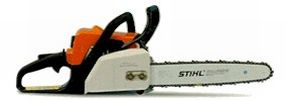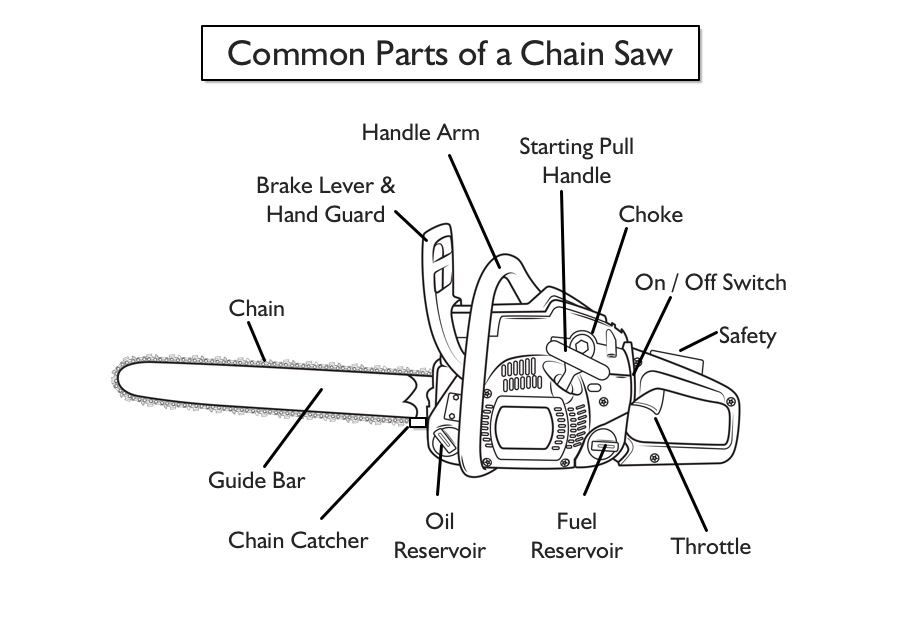How to Buy a Chain Saw
If you own land, a chain saw can be a great time and money saver. Instead of using an ax or calling in a landscaper to remove broken tree limbs, bring down dead trees, or cut firewood -- you can do it yourself.
 |
 |
Shown above, Craftsman electric chain saw (left), Stihl gas chain saw (right) |
|
If you need a chain saw only once, consider a rental. Most equipment rental stores (and many hardware stores) rent chain saws. They usually rent for around $50 / day. However, if you anticipate using the saw more than once, a purchase might be the better choice. You won't have to rush through jobs. And you can be sure your saw is in top condition, i.e. a sharp chain, no mechanical problems.
Avoid used chain saws. The time and energy you spend getting the saw to work correctly will outweigh any cost savings. In addition, newer saws have more safety features. With new gas saws starting at $100, it just makes more sense to buy new.

1
Types of Chain Saws
- Grades - Chain saws are made in 3 grades:
- Professional saws are made for daily use and are built to handle a great deal of abuse.
- Standard saws are similar to professional saws, but are designed to be more flexible in their application.
- Consumer saws are designed for occasional use and are less expensive than professional and standard grade chain saws. Most homeowners buy consumer saws.
- Fuel / Power - Chain saws are either electric or gas powered. Electric saws are typically less expensive, quieter to operated, cleaner, require less maintenance, but are limited in where they can be used due to the required power cord. Gas saws are typically more expensive, noisier, more powerful, and allow more flexibility in where they can be used. Most gas-powered saws have a two-stroke (i.e. two cylinder) motor that uses a special oil mixed directly into the gasoline fuel. A few rechargeable battery powered saws exist, but they lack the power for most jobs.
2
Important Attributes
- Safety - a few of the more common safety features are as follows:
- chain brake - a system to automatically stop the saw in the event of kickback (kickback is when the chain on the tip or top of the bar gets pinched and sends the cutting edge of the saw back and up towards the operator)
- chain type - a chain design that minimizes kickback
- hand guards - a lever in front of the handle which will stop the saw in case of kickback
- chain catcher - a metal tab that keeps a broken chain from flying towards the operator
- shielded muffler - a muffler mounted between the engine and the bar to direct heat and noise away from the operator
- ANSI - look for saws that meet ANSI safety standards
- Engine size - Larger engines can accommodate larger bars and get the job done faster. However, the weight of a saw increases as the engine size increases. Electric saws measure the engine size in amps, gas saws measure the engine size in displacement (cubic centimeters) or horsepower.
- Bar size - The bar is the metal extension that the cutting chain is wrapped around, bar sizes typically range from 14 to 20 inches. Shorter bars reduce weight and optimize the power of a saw. Choose a bar length that is best for the size tree that you will be cutting most often. You can cut a tree up to twice the length of the bar if necessary.
- Design - Look for a well-balanced saw body with a high center of gravity.
- Heated Handle - For use in very cold conditions, consider a saw with a heated handle.
- Automatic oiler - a system that removes the need to periodically oil the chain
- Visible fuel and chain oil levels - a design feature that makes maintenance easier
- Anti-vibration system - bushings or springs between the handle and the motor to reduce vibrations for the operator
- Serviceability - easy access to the air filter and spark plug. Also look for a side-mounted chain tensioning to save time and effort.
- Warranty - most saws come with a 1-year limited warrantee that covers parts and labor.
3
How To Choose
- Determine your required grade of saw based on frequency of use. Those needing a saw for constant use should consider a standard or professional saw. Occasional users should consider a standard or consumer saw.
- Determine the ideal power type. Buy a gasoline-powered chain saw if you need mobility or are cutting large logs. Electric saws are fine for small branches or light jobs.
- Choose the right size chain saw. Buy a saw with a bar long enough for you largest job. But buy the smallest a lightest saw possible
- Verify the safety features and compare warrantees before making a purchase.
Written by Brian P. Sorge, Senior Partner, Euclid Construction
